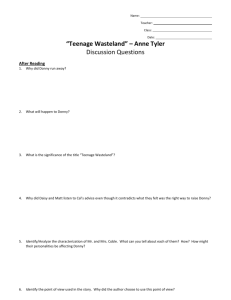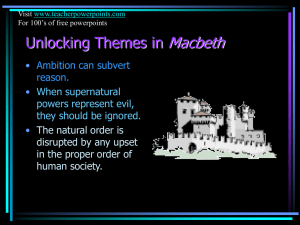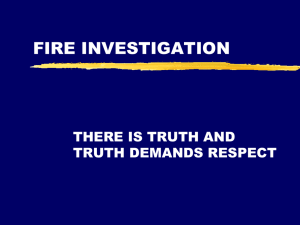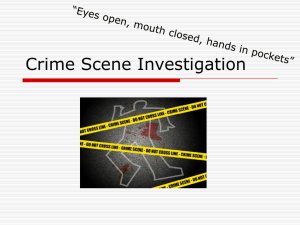Fire Origin & Cause Determination: Firefighter I Training
advertisement
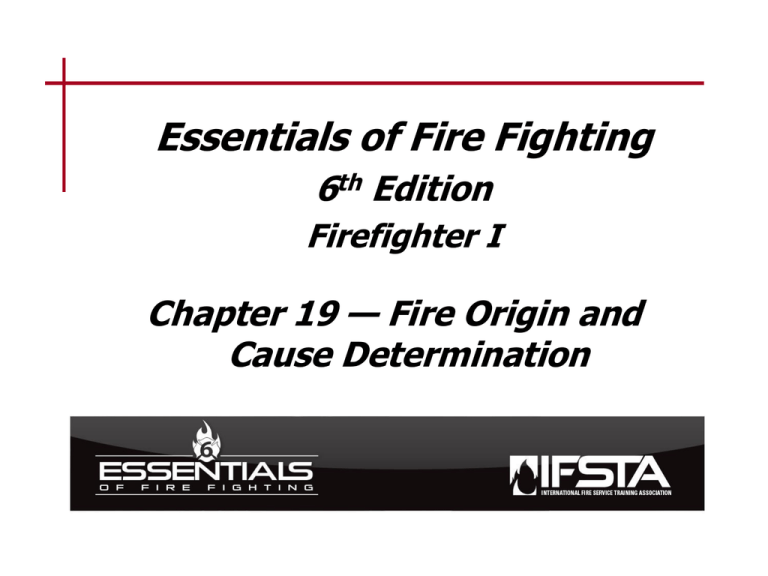
Essentials of Fire Fighting 6th Edition Firefighter I Chapter 19 — Fire Origin and Cause Determination Learning Objective 1 Explain ways to recognize obvious signs of the area of origin. 19–1 The area of origin contains several pieces of important information. Assume • Precise point of origin, ignition • Greatest amount of damage, debris • Potentially lethal concentrations of gas present • Monitor air • Wear full PPE Area of origin 19–2 Debris on scene contains fire cause indicators and must remain in place. Courtesy of Donny Howard May be used in court Arson – Criminal charges 19–3 You must control evidence and remember information from the incident as much as possible. Control evidence Remember from on scene – What you Chain of custody Required in legal cases See Smell Hear 19–4 CAUTION You should minimize fire suppression and overhaul activities that could destroy important evidence regarding the origin and cause of the fire. 19–5 Several factors will influence locating the area of origin and the overall success of the investigation. May be apparent, if not Critical to overall success • Follow from least damage to most • Identify witnesses • Secure scene • Note initial scene Incident Commander or fire/criminal investigator Wildland or ground cover fire • Determine point fire started, fire cause • Protect or collect evidence • May require experienced investigator 19–6 Courtesy of Donny Howard The search for area of origin at a structure fire begins outside. 19–7 You should know actions to take when the origin cannot be determined. Delay overhaul beyond locating, extinguishing fires Protect scene Establish scene security 19–8 Preliminary assessment and exterior examination require specific tasks. Exam scene to determine Document, preserve 19–9 Specific observations The interior examination begins in the area of least damage and works toward the area of greatest damage. Fire indicators to use: Courtesy of Donny Howard Fire patterns Melted metal, glass Degree of damage 19–10 Courtesy of Donny Howard Charring on floors and vertical surfaces can indicate useful information. Where fuel burned in that location Face toward area or point of origin 19–11 Area of origin and fire spread factors should be closely examined. Multiple areas of origin • May indicate intentionally set • Unintentional may give same appearance Factors affecting fire spread • Materials in fire’s path • Building features, layout • Ventilation openings • Fire load • Fire suppression tactics • Activation of suppression systems Be aware of general patterns • Call investigator if there is a question 19–12 Courtesy of Donny Howard Total structural fire loss presents unique investigation challenges. 19–13 Exterior fires involve several different types of materials. Stored materials Debris Trash Rubbish Ground cover or vegetation 19–14 Ground cover fires require specific understanding of several concepts. Basic fire behavior Effects of winds Topography Natural fuels on fire spread Burns outward in all directions 19–15 Fire burns in equal directions when on flat ground and without wind. 19–16 The rate and direction of spread of ground cover fires are affected by several components. • • • • • • • Wind direction Wind velocity Terrain/topography Types of fuel Ambient temperature Relative humidity Moisture content of fuel 19–17 Ground cover fires require specific understanding of several concepts. Area of origin may display • Evidence of slower, less intense fire growth • Unburned materials • Effects of flame on fuels less than at head Radiant heat affects adjacent fuels • Backsides of grass, trunks protected • Grass will fall toward area of origin • White ash product of more complete combustion 19–18 Finding the area of origin for vehicle fires is similar to the structural process. Search for area of origin Interview witnesses, firefighters 19–19 Examine exterior, interior Vehicle fires require knowledge and practice of several safety guidelines. Ensure undeployed air bags inoperable Ensure shock absorber bumpers inoperable Hybrid, electric car considerations Do not cut posts that contain restraint systems Know where large capacity or multiple fuel cells may exist Hydraulic system considerations Check trunk area for flammable/ combustibles 19–20 WARNING Do not attempt to access or examine a vehicle unless you know how to do so safely. 19–21 REVIEW QUESTION What ways can a Firefighter I recognize obvious signs of a fire’s area of origin? 19–22 Learning Objective 2 Describe the relationship between fire cause classifications and cause determination. 19–23 Fire cause determination is a critical step in the investigation process. Look for Determination can • Competent ignition source • Ignition sequence • Document causes of fire • Indicate trends in unsafe behavior • Indicate defective equipment, design flaws • Indicate malicious, illegal behavior 19–24 The National Fire Incident Reporting System (NFIRS) reports several causes of fires in structures. Incendiary Open flame, ember, or torch Other heat, flame, or spark Smoking materials (Cont.) 19–25 The National Fire Incident Reporting System (NFIRS) reports several causes of fires in structures. Lightning, natural Heating equipment Cooking equipment Electrical or lighting equipment (Cont.) 19–26 The National Fire Incident Reporting System (NFIRS) reports several causes of fires in structures. Heating, ventilating, and air-conditioning (HVAC) appliances Other equipment Exposure Children playing with matches, lighters, or other ignition sources 19–27 There are four types of fire cause classifications. Natural Incendiary Courtesy of Iowa Fire Service Training Bureau. Courtesy of Donny Howard Accidental 19–28 Undetermined Courtesy of Bob Espositio There are several obvious signs of cause you should look for. 19–29 DISCUSSION QUESTION What are some visual signs that may determine the area of origin for ground cover fire? 19–30 Absence of an obvious ignition source can help investigations. Eliminate some causes Focus on other causes 19–31 REVIEW QUESTION What is the relationship between fire cause classifications and cause determination? 19–32 Learning Objective 3 Recognize signs of arson. 19–33 You will need to provide information if an incendiary or undetermined initial cause is indicated. Gather based on Different personnel may perform formal investigation • Observations • Local or state fire investigators • Law enforcement officials (Cont.) 19–34 Courtesy of Donny Howard You will need to provide information if an incendiary or undetermined initial cause is indicated. Time of day Weather, natural hazards Manmade barriers People leaving the scene 19–35 Additional information should also be gathered to assist investigators. Time of arrival and extent of fire Wind direction and velocity Doors or windows locked or unlocked Location of fire (Cont.) Courtesy of Donny Howard 19–36 Additional information should also be gathered to assist investigators. Burglary tools Courtesy of Donny Howard Containers or cans 19–37 Familiar faces Conditions should also be observed to provide information for investigators. Unusual odors Abnormal behavior of fire when water applied Obstacles hindering fire fighting Incendiary devices (Cont.) 19–38 Conditions should also be observed to provide information for investigators. Structural alterations Trailers Courtesy of Donny Howard Fire patterns Heat intensity 19–39 (Cont.) Conditions should also be observed to provide information for investigators. Availability of documents Fire detection and protection systems Intrusion alarms Location of fire 19–40 (Cont.) Conditions should also be observed to provide information for investigators. Courtesy of Donny Howard Personal possessions Household items Equipment or inventory 19–41 Business records REVIEW QUESTION How can a Firefighter I recognize signs of arson? 19–42 Learning Objective 4 Describe the importance of preserving evidence. 19–43 Learning Objective 5 Explain techniques for preserving evidence. 19–44 Preserving evidence requires understanding certain principles. Responsibility of all at scene Protect everything that looks odd, suspicious Do not determine what is/is not unless qualified 19–45 There are several important aspects of protecting the fire scene. Scene security - First First-arriving investigator • Early security measures • Restrict scene access • Protect potential evidence • Minimize suppression, overhaul activities that could destroy information • May adjust or implement new measures • Decision factors • May request monitoring of each entrance, exit to document individuals on scene 19–46 Explosions Structure 19–47 Courtesy of Ron Moore, McKinney (TX) Fire Department Establishing a scene perimeter requires specific knowledge. There are several ways to establish perimeters that are both recognizable and enforceable. Ensure initial larger than needed Ensure visible, recognizable 19–48 Use law enforcement or firefighters to control Procedures for criminal investigations also impact scene security practices. Keep entry log Permit access to only those authorized Move personnel to staging area when tasks complete Ensure others always escorted Mark potential evidence to prevent disturbing 19–49 There are several techniques used to preserve evidence. Keep evidence untouched, undisturbed Do not gather or handle unless necessary to preserve Document all actions Follow department SOPs (Cont.) 19–50 There are several techniques used to preserve evidence. Avoid walking on, crosscontaminating, or destroying Avoid excessive water use Protect footprints, tire marks Close dampers and other openings Leave charred documents Protect documents from air flow 19–51 Overhaul operations can be detrimental to an investigation. May destroy potential evidence Delay until origin and cause determined 19–52 Begin once critical evidence protected Courtesy of Donny Howard Even when a scene is secure, contamination or spoliation can occur. Contamination Spoliation 19–53 Follow local procedures when finalizing operations and investigations. After investigation complete Debris removal • Secure structure, turn over to occupant • Perform according to local SOPs • Follow local protocol • May be last activity • Prevent rekindle • Separate unburned • Dump debris where not visible if possible 19–54 REVIEW QUESTION What are some techniques firefighters can use to preserve evidence? 19–55 Summary • One of the most important responsibilities is protecting evidence. • Use appropriate caution in the area of origin. • A thorough investigation can be conducted to determine the exact cause of the fire. 19–56
